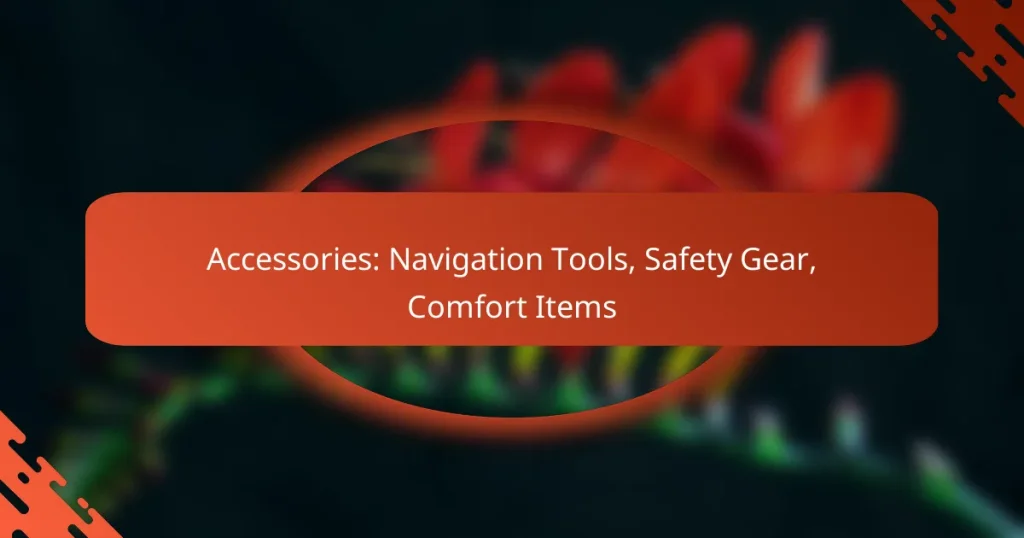Packing for a safari tour in Africa is crucial for ensuring a comfortable and safe experience. Focus on lightweight, breathable clothing and essential gear that protects against the sun and insects, while also considering the specific environment and activities planned. By prioritizing versatile items and minimizing bulk, you can enjoy your adventure without unnecessary hassle.
Clothing: Breathability, Comfort, Sun Protection
Cameras: Resolution, Zoom, Durability
Travel Insurance: Coverage Types, Claims Process, Important Considerations
Footwear: Traction, Comfort, Terrain Suitability
Packing Tips: Seasonal Gear, Essentials, Weight Management
Accessories: Navigation Tools, Safety Gear, Comfort Items
What should I pack for a safari tour in Africa?
Packing for a safari tour in Africa requires careful consideration of clothing, footwear, accessories, and gear to ensure comfort and safety. Prioritize lightweight, breathable materials and items that protect against the sun and insects.
Essential clothing for safari
For a safari, opt for lightweight, breathable clothing in neutral colors like khaki, beige, or olive to blend in with the environment. Long-sleeved shirts and long pants are recommended to protect against sunburn and insect bites.
Layering is key, as temperatures can vary significantly between day and night. Consider packing a light jacket or fleece for cooler evenings, and a wide-brimmed hat for sun protection.
Recommended footwear for safari
Comfortable, sturdy footwear is essential for a safari. Choose closed-toe shoes or boots that provide good ankle support and traction, as you may encounter uneven terrain.
Lightweight hiking shoes or sandals with straps can be suitable for warmer days, but ensure they are durable enough for walking. Bring an extra pair in case one gets wet or muddy.
Must-have accessories for safari
Accessories can enhance your safari experience. A good pair of binoculars is invaluable for wildlife viewing, allowing you to observe animals from a distance without disturbing them.
Additionally, a camera with a zoom lens is essential for capturing memories. Don’t forget a power bank to keep your devices charged during long days in the field.
Important gear for wildlife viewing
When it comes to wildlife viewing, a quality pair of binoculars is a must-have. Look for binoculars with a magnification of at least 8x for optimal viewing from a distance.
A field guidebook or app can help you identify animals and plants you encounter. Consider a lightweight backpack to carry your gear comfortably while on safari.
Health and safety items for safari
Health and safety should be a priority on your safari. Pack a basic first-aid kit that includes band-aids, antiseptic wipes, and any personal medications you may need.
Insect repellent containing DEET is essential to protect against mosquito bites, and sunscreen with high SPF is important for sun protection. Lastly, consider travel insurance that covers medical emergencies while abroad.
How do I choose the right safari gear?
Choosing the right safari gear involves considering the environment, weather conditions, and the activities planned during the safari. Essential items include durable clothing, appropriate footwear, and gear that provides protection from the elements and wildlife.
Factors to consider when selecting gear
When selecting safari gear, prioritize comfort, durability, and functionality. Look for lightweight, breathable fabrics that offer sun protection and moisture-wicking properties. Consider the climate of your destination; for instance, tropical regions may require lighter clothing, while cooler areas might need layers.
Footwear is crucial; opt for sturdy, waterproof boots that provide good ankle support. Additionally, think about accessories such as hats, sunglasses, and insect repellent to enhance your experience. Always check the specific requirements of your safari operator, as some may have recommendations or restrictions on gear.
Top brands for safari equipment
Several brands are renowned for their quality safari equipment. Brands like Columbia, North Face, and REI offer a range of clothing and gear designed for outdoor adventures. These companies focus on durability and comfort, making them popular choices among safari-goers.
For footwear, Merrell and Salomon are highly regarded for their hiking boots, providing excellent support and traction. When it comes to accessories, brands like Tilley and Outdoor Research offer hats and sun protection gear that are ideal for safari conditions. Always check for customer reviews and product specifications to ensure you choose the best options for your needs.
What are the best safari packing tips?
The best safari packing tips focus on bringing essential items while minimizing bulk. Prioritize lightweight, versatile clothing and gear that can withstand various weather conditions and terrains.
Efficient packing techniques
To pack efficiently for a safari, roll your clothes instead of folding them. This method saves space and reduces wrinkles. Use packing cubes or compression bags to keep items organized and compact.
Consider the weight limit imposed by airlines or safari operators, typically around 15-20 kg for checked luggage. Keep your most important items, like documents and medications, in your carry-on for easy access.
How to organize your safari bag
Organize your safari bag by categorizing items into sections. Group clothing, toiletries, and gear separately to streamline packing and unpacking. Use smaller bags or pouches for items like chargers, first aid supplies, and personal items.
Label your bags or use color-coded pouches to quickly identify contents. This approach saves time when you need to find something during your trip, ensuring a smoother safari experience.
What are common mistakes when packing for a safari?
Common mistakes when packing for a safari include overpacking and neglecting essential items. These errors can lead to unnecessary stress and discomfort during your trip.
Overpacking issues
Overpacking can make travel cumbersome, especially in a safari setting where space is limited. Many travelers bring too many clothes or unnecessary gadgets, which can weigh down luggage and complicate mobility.
A good rule of thumb is to limit clothing to a few versatile pieces that can be mixed and matched. Aim for lightweight, quick-drying fabrics that are suitable for both warm days and cooler evenings.
Neglecting essential items
Neglecting essential items can lead to discomfort and missed opportunities during your safari. Commonly forgotten items include sunscreen, insect repellent, and a good pair of binoculars for wildlife viewing.
To avoid this pitfall, create a checklist of must-have items before packing. Include practical essentials like a reusable water bottle, a hat for sun protection, and a first-aid kit to ensure you are well-prepared for your adventure.
How does climate affect safari packing?
Climate plays a crucial role in determining what to pack for a safari, as weather conditions can vary significantly by season and region. Understanding these variations helps ensure comfort and safety during your adventure.
Understanding seasonal variations
Safari seasons typically fall into dry and wet periods, with dry seasons offering clearer skies and better wildlife visibility. Wet seasons, on the other hand, can bring heavy rains and muddy conditions, which may affect accessibility and comfort.
In East Africa, for example, the dry season generally runs from June to October, while the wet season occurs from November to May. Knowing these patterns helps in planning your packing list effectively.
Climate-specific clothing recommendations
For dry seasons, lightweight, breathable fabrics are ideal to keep you cool during the day, while layering is essential for cooler evenings. Neutral colors, such as khaki and olive, are recommended to blend in with the environment and avoid attracting insects.
During wet seasons, waterproof jackets and sturdy, quick-drying footwear are crucial. Consider packing moisture-wicking base layers and a warm fleece for chilly mornings and evenings. Always check the specific climate of your safari destination to tailor your packing accordingly.
What are the best travel accessories for safari?
The best travel accessories for safari enhance your experience and ensure comfort and safety. Key items include durable bags, protective gear, and gadgets that cater to the unique environment of the safari.
Recommended travel gadgets
When preparing for a safari, consider gadgets that improve convenience and safety. A good quality power bank is essential for keeping your devices charged, especially in remote areas where electricity may be limited. A portable water purifier can also be invaluable, allowing you to drink safely from natural sources.
Additionally, binoculars are a must-have for wildlife viewing, enabling you to observe animals from a distance without disturbing them. Look for lightweight models with good magnification, ideally between 8x and 10x, to enhance your experience.
Essential personal items for comfort
Comfort is crucial during a safari, so pack items that help you stay relaxed. Lightweight, breathable clothing is essential, as temperatures can vary significantly throughout the day. Opt for moisture-wicking fabrics and layers that can be added or removed as needed.
Don’t forget a good pair of hiking boots or sturdy sandals, as you’ll likely be walking on uneven terrain. A wide-brimmed hat and high-SPF sunscreen are also important to protect against sun exposure. Finally, consider bringing insect repellent to ward off mosquitoes and other pests, especially in the evenings.
How can I prepare for a safari in different regions?
Preparing for a safari varies by region due to differences in climate, wildlife, and cultural practices. Understanding these regional nuances will help you pack effectively for a safe and enjoyable experience.
Regional packing differences
When planning a safari, consider the specific environment of your destination. For example, safaris in East Africa, such as Kenya or Tanzania, often require lightweight, breathable clothing due to warm temperatures and dry conditions. In contrast, safaris in Southern Africa, like South Africa or Botswana, may necessitate warmer layers for cooler evenings and mornings.
Additionally, the type of wildlife you may encounter can influence your packing choices. In regions with dense vegetation, such as the Okavango Delta, consider packing insect repellent and long-sleeved clothing to protect against mosquitoes. Conversely, in open savannah areas, neutral-colored clothing can help you blend in with the surroundings.
Lastly, always check the specific regulations and recommendations for your chosen safari destination. Some parks may have restrictions on certain items, such as drones or specific types of food, so being informed will ensure compliance and enhance your experience.






